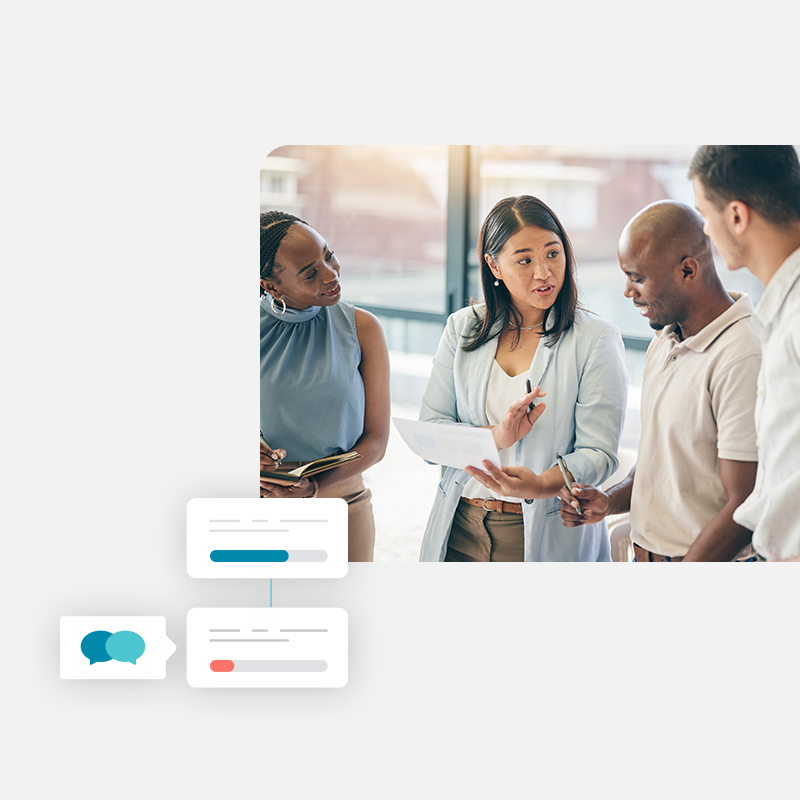Think of attrition as a virus to your enterprise. An effective course of treatment can minimize its impact but, if left unfettered, the repercussions can be devastating, quickly spreading to infect every corner of your organization. Although we’ve spoken at length about the causes of that attrition-based infection, its sometimes surprising roots, and how organizational culture is an ever-present factor in driving its toxic effects, Betterworks Engage now wants to focus on finding practical solutions for your enterprise’s attrition ailments.
Like most issues presented to organizations in a turbulent and fluid marketplace, a well-informed approach is essential to constructing effective strategies to find resolve, the forces behind attrition included. Therefore, understanding the causes driving turnover with pertinent, real-time information and thorough insights is imperative to minimizing your employee turnstile, increasing productivity, and avoiding unnecessary labor and training costs.
With Betterworks Engage’s technology-driven feedback solutions, you’ll never again have to rely on mere intuition or best guesses to form policies and a healthy, satisfying culture. Simply put, accurate people analytics enhances the employee experience and makes employees want to stay with your organization, simultaneously attracting new talent as well. Rampant attrition doesn’t have to be a part of doing business anymore. Give Betterworks Engage a few minutes and we’ll show you how to vastly improve your employee retention.
Make Retention a Priority
HR is naturally on the frontlines of the battle against attrition. Like any formidable foe, understanding what you’re up against is the first crucial step in developing an effective strategy to thwart it. In the case of attrition, the following statistics should be enough to make any HR department stand up and take notice of the absolute importance of employee retention in the modern workplace:
- A third of management in medium to large sized organizations are looking for a new job
- 78% of executives consider attrition an urgent matter to their enterprise
- 33% of employees know if they plan on staying at a job long-term after just one week
- 32% of organizations already expect their employees to change employers
- A third of all new hires quit after six months on the job
Attrition doesn’t discriminate, hitting organizations at all levels and stages of the employee journey. While most of HR and management are already cognizant of the severity of the problem, they have traditionally lacked adequate tools and insight to take proper steps. As the old saying goes, however, knowing is half the battle. A structured approach to alleviating turnover that relies on technology as a guide is an organization’s most effective means of eliminating attrition, beginning with the identification of the problem itself.
Know Thy Attrition Enemy
One of the many benefits of using technology, specifically AI and machine learning, to curb attrition is its prescient, predictive abilities. However, even the most advanced of systems lack a proper sense of direction if an employer doesn’t take the time to identify, understand, and strategize around the specific factors driving turnover within a workforce. Although, once again, Betterworks Engage has discussed the following top factors driving attrition, a brief recap is in order:
- Alignment and involvement
- Collaboration and teamwork
- Employee enablement
- Management
- Feedback and recognition
As previously detailed, it’s important to note that compensation is not amongst the top five factors driving attrition. In many instances, the actual drivers are far more nuanced and subtle than simple compensation or benefits. Therefore, employers are well served paying close attention to trends and behavior patterns, both quantifiable and qualitative in nature, that might be a harbinger of an exiting employee.
- Spotty attendance: A disengaged team member contemplating a career change often lacks motivation and will display inconsistent attendance, including extended, unscheduled leaves.
- Substandard performance: When an employee feels disconnected to their role and employer, effort and quality of work are often the first to suffer, making missed deadlines and excessive mistakes more obvious and common.
- Indifferent attitude: Employees that simply don’t care about events and dynamics happening within the organization and work environment are ambivalent about success, goals, and a healthy, satisfying workplace.
- Tone: When a team member suddenly becomes more vocal with their negative experiences within the organization, both with management and through informal conversation with peers, the employee is making little attempt to hide their dissatisfaction and is often planning to leave.
While this list is in no way exhaustive, it does highlight some of the most overt behaviors that signify an exit from the organization. However, every employer and workforce is different so it is important to look for other signs that might be specific to your enterprise. Once you have identified the cause or causes behind turnover, you must also gauge the scope of the issue by analyzing the damage already caused, primarily through two critical metrics:
- Source and rate of retention: Take a close look at your resignation rate, using a data sample that stretches back before turnover escalated. In doing so, take note of which employees left, particularly they were amongst your best and brightest.
- Productivity/business metrics: Likewise, look at your business metrics against your resignation rate to measure any correlation between turnover and key numbers like revenue and profitability. Although performance metrics typically lag behind your resignation rate, identifying a trend between the two could indicate that loss of skill and talent within your workforce has already had a demonstrable effect on productivity and success.
Target Employees That Add the Most Value
To throw a slight wrench into the mix, Betterworks Engage must remind you that not all turnover is necessarily bad. In fact, a modicum of attrition is healthy for an organization, more evolutionary in its impact on a workforce as those that don’t fit well into your culture and goals will naturally be replaced by more capable, engaged, and productive workers. This is the step where a strategic view towards attrition will benefit the enterprise most.
Throughout the process, HR must adopt a forward-looking perspective, taking note of the employees that add the most value to the organization and concentrate their efforts on retaining those key team members that are producers and innovators within their individual roles. Therefore, HR should avoid a uniform approach to their retention efforts and, instead, divert their limited time and resources towards those employees most capable of driving organizational growth while adhering well to the culture.
As before, a data-driven approach can be immensely helpful in this endeavor, building on the retention rates and various business metrics developed while identifying the cause of attrition to narrow your scope further. In essence, your trying to isolate the segments of your workforce that exhibit high turnover rates, affect your production metrics most, and are most susceptible to the dynamics driving attrition within your organization. These are the individuals that would create the most significant impact on your enterprise if they were to leave and, thus, should be the focus of your retention initiatives. An additional set of metrics is helpful in uncovering these employees, including:
Turnover Segments
Take a deeper dive into your resignation rate data and analyze how it differs across various departments, functions, lengths of employment, age and demographic segments. Likewise, compare those data points to individual performance levels in your business metrics to better understand how the different components of your workforce perceive and respond to the overall employee experience. The results of your efforts will be a critical guide in helping you decide which particular programs, systems, and procedures will result in the most substantial positive impact on your productivity and overall organization.
Predictive Analytics
Obviously driven by technology, several platforms are available that use AI to uncover buried insights within your data to reveal which employee segments or even individual employees pose the highest risk of exiting your organization. Once again, compare this to your performance and business metrics to identify those segments and individuals with low retention rates but high added value to the enterprise. Collectively, these efforts will help you be far more proactive in identifying and taking action on the dynamics that drive the most damaging sources of attrition within your organization. Such abilities allow you to stay ahead of the turnover curve and address issues before an employee starts displaying the previously mentioned indicators of an impending exit from your workforce.
Take Informed, Targeted Action
By now, you’ve identified which segments you should target with your retention initiatives and must now transform that information into precise action. This is where feedback can be particularly useful, allowing you to better understand what motivates the different segments and individuals within your workforce, and what actions on your part feed those motivations best. Betterworks Engage’s feedback platform combines convenience and insightful people analytics through a combination of tools, including heat maps, surveys, pulse polls, and other techniques to help you reveal what drives those motivations. That critical information will be invaluable in steering your retention initiatives and developing programs with maximum impact on retention rates.
The insights derived from Betterworks Engage, coupled with the following metrics, will result in a clear picture of what specific actions you should initiate to have an immediate and tangible effect on your attrition rates:
Promotion Rates
If either or both of your analysis and feedback from Betterworks Engage’s platform reveal a lack of career advancement opportunities as a driver to attrition, take the time to thoroughly understand how your organization handles promotions. Identify the teams or departments that develop the most promotable employees and see what they’re doing differently with respect to the rest of your organization. Take those best practices and integrate them into an enterprise-wide program that, with time, will increase opportunities for promotion and create a greater incentive for your employees to excel within their roles.
Training and Development
With busy schedules and significant workloads, it’s too easy for training and development programs to fall by the wayside. However, skill and knowledge enhancement works hand-in-hand with career advancement and is a tremendous incentive for your workforce to grow and succeed. Look for a correlation between retention, value, and individuals that participated in particular training and development programs to justify a learning budget that allows you to invest in additional skill enhancement systems.
Onboarding
Although Betterworks Engage has discussed onboarding at length in the past, it plays a critical role in your attrition rates. Use effective feedback programs to inform and guide your onboarding approach, creating an engaging atmosphere that immerses a new hire into your culture and provides a solid foundation for a long and productive tenure with your organization. For example, the people analytics provided by Betterworks Engage’s feedback platform throughout the onboarding process will help you create a customized strategy that specifically targets a new hire’s strengths. A feedback-driven approach maximizes the lasting impact of your onboarding program.
Natural Turnover
Workforce demographics are experiencing swift and significant change as baby boomers retire and millennials rise up the food chain to take their place. Analyze the demographic makeup of your different employee segments to determine which of them are most susceptible to those natural sources of turnover. Then concentrate your efforts on developing and incentivizing the team members that are most likely to fill in those position gaps.
Of course, some degree of turnover is natural and even healthy to an organization. However, excessive attrition is cancerous to your culture, productivity, and viability. Be diligent in your analysis, follow the steps we’ve outlined to identify and take action on the most susceptible segments of your workforce, and take full advantage of the people analytics provided by Betterworks Engage’s platform to steer your efforts. Organizations that effectively manage their turnover rates will always have a significant advantage to competitors that continue to drown in the oppressive effects of high attrition. With Betterworks Engage’s help, you can always rise above the pack.


